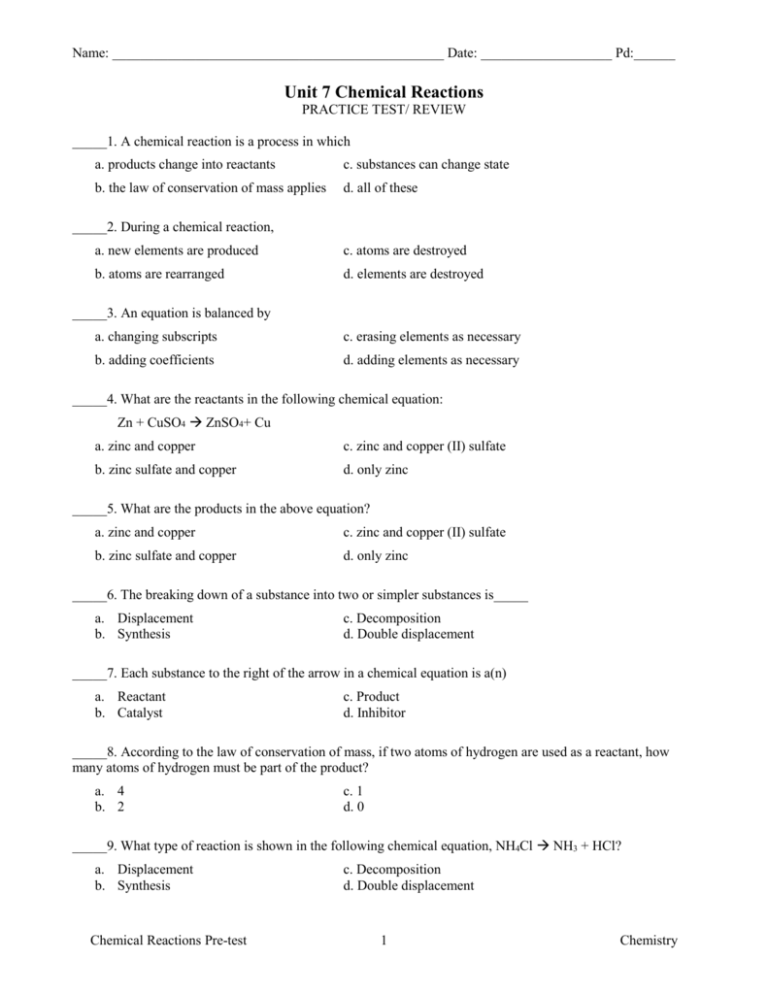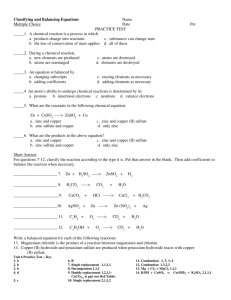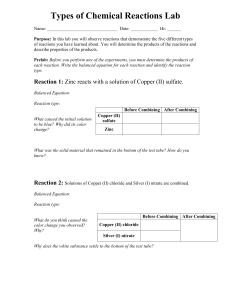Chemical Reactions Practice Test/Review - High School Chemistry
advertisement

Name: ________________________________________________ Date: ___________________ Pd:______ Unit 7 Chemical Reactions PRACTICE TEST/ REVIEW _____1. A chemical reaction is a process in which a. products change into reactants c. substances can change state b. the law of conservation of mass applies d. all of these _____2. During a chemical reaction, a. new elements are produced c. atoms are destroyed b. atoms are rearranged d. elements are destroyed _____3. An equation is balanced by a. changing subscripts c. erasing elements as necessary b. adding coefficients d. adding elements as necessary _____4. What are the reactants in the following chemical equation: Zn + CuSO4 ZnSO4+ Cu a. zinc and copper c. zinc and copper (II) sulfate b. zinc sulfate and copper d. only zinc _____5. What are the products in the above equation? a. zinc and copper c. zinc and copper (II) sulfate b. zinc sulfate and copper d. only zinc _____6. The breaking down of a substance into two or simpler substances is_____ a. Displacement b. Synthesis c. Decomposition d. Double displacement _____7. Each substance to the right of the arrow in a chemical equation is a(n) a. Reactant b. Catalyst c. Product d. Inhibitor _____8. According to the law of conservation of mass, if two atoms of hydrogen are used as a reactant, how many atoms of hydrogen must be part of the product? a. 4 b. 2 c. 1 d. 0 _____9. What type of reaction is shown in the following chemical equation, NH4Cl NH3 + HCl? a. Displacement b. Synthesis Chemical Reactions Pre-test c. Decomposition d. Double displacement 1 Chemistry _____10. When most chemical reactions take place, some ____ in the reactants must be broken, a process that requires energy. a. Chemical bonds b. Products c. Precipitate d. Catalyst _____11. A(n) _____ chemical equation has the same number of atoms of each element on each side of equation. a. Complex b. Simple c. Unbalanced d. Balanced _____12. A chemical reaction in which two or more substances combine to form another substance a. Synthesis b. Reactant c. Decomposition d. Product Short Answer Classify the reaction according to the type it is. Put that answer in the blank. Then add coefficients to balance the reaction when necessary. H2SO4 _____________________ 13. Zn + _____________________ 14. H2CO3 _____________________15. CaCO3 + HCl _____________________16. AgNO3 + Zn _____________________ 17. C3H8 + _____________________ 18. C2H5OH + Chemical Reactions Pre-test CO2 + O2 O2 ZnSO4 + H2 H2O CaCl2 + H2CO3 Zn(NO3)2 + CO2 + CO2 + 2 Ag H2O H2O Chemistry Write a balanced equation for each of the following reactions: 19. Magnesium chloride is the product of a reaction between magnesium and chlorine. 20. Copper (II) hydroxide and potassium sulfate are produced when potassium hydroxide reacts with copper(II) sulfate. 21. Sodium Hydroxide and Iron (III) Chloride react to produce Sodium Chloride and Iron (III) Hydroxide. Based on the type of reaction given, predict and then balance the following equations: 22. (Decomposition) KClO3 ? Balanced Chemical Equation: __________________________________________________________ 23. (Double Replacement) CaCl2 + Na2CO3 ? Balanced Chemical Equation: __________________________________________________________ Chemical Reactions Pre-test 3 Chemistry 24. (Synthesis) Sodium and Oxygen ? Balanced Chemical Equation: __________________________________________________________ 25. (Single Replacement) Iron (II) Chromate + Aluminum ? Balanced Chemical Equation: __________________________________________________________ 26. (Combustion) C4H10 + O2 ? Balanced Chemical Equation: __________________________________________________________ STUDY: Notes (Powerpoint) Worksheets Reactions lab Balancing Equations Types of Reactions Nomenclature (covalent, ionic, acids) Chemical Reactions Pre-test 4 Chemistry











